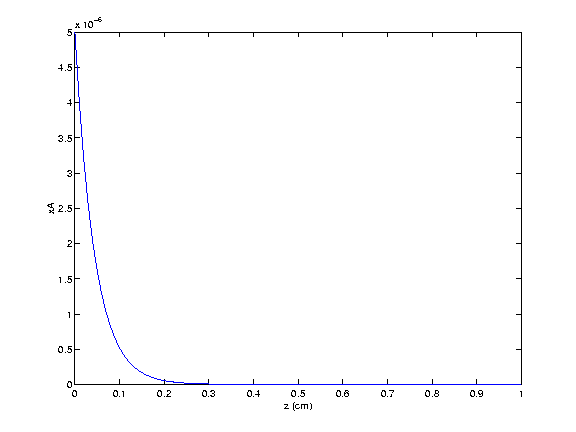![[Maple Math]](images/ex11.gif)
Numerical
Example 1
This example shows how to use the relationship obtained to solve problem 18.C in Bird, Stewart, and Lightfoot. In this example, the concentration of the A component (albumin) is so small that we assume the concentration of the B component (water) to be constant (ie- xB = xB0). This simplification allows for an analytical solution to equation 18.5-18, and thus MAPLE can easily be used to solve for the concentration profile of albumin.Data Given
centrifugal field = 50,000 times force of gravity
cell length = 1.0 cm
molecular weight of albumin (component A) = 45,000
apparent density of albumin in solution = MA/VA = 1.34 g/cm3
mole fraction of albumin at z = 0, xA0 = 5x10-6
apparent density of water in then solution = 1.00 g/cm3
temperature = 75oF
MAPLE solution
> restart;
> eq:=(xA(z)/xA0)^VBbar=exp((VAbar*MB-VBbar*MA)*gom*z/(R*T));
![[Maple Math]](images/ex11.gif)
> xA(z):=solve(eq,xA(z)):xA:=unapply(xA(z),z);
![[Maple Math]](images/ex12.gif)
> coef:=(VAbar*MB-VBbar*MA)*gom/(VBbar*R*T);
> MA:=45000*g/mol:
> MB:=18*g/mol:
> VAbar:=MA/rhoA:
> rhoA:=1.34*g/cm^3:
> VBbar:=MB/rhoB:
> rhoB:=g/cm^3:
> T:=(75+460)/1.8*K:
> R:=8.314e7*g*cm^2/(s^2*mol*K):
> gom:=50000*980.665*cm/s^2:
> xA0:=5e-6:xA(z);
![[Maple Math]](images/ex14.gif)
This is the same result that BSL obtained for the concentration profile.
